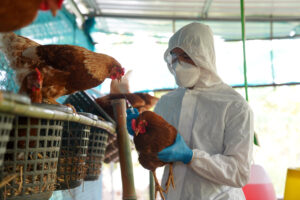Last week, FDA published the first of its findings from a large-scale microbiological surveillance sampling program that it began in 2014 to learn more about the prevalence of disease-causing bacteria and to assist in the identification of patterns that may help predict and prevent future contamination. Through the program, FDA collects a statistically determined number of samples from a variety of commodities over a 12- to 18-month period and tests them for certain types of foodborne-illness bacteria. FDA’s prior approach was to collect a relatively small number of samples for many different commodities over many years. The first test results released were those of raw milk cheese aged 60 days, cucumbers, and hot peppers: FDA elected to sample raw milk cheese aged 60 days for the first year of testing because evidence indicated that the aging may not eliminate or adequately reduce the bacteria. After testing 1,606 samples in 2014 and 2015, FDA found the cheese to have less than a 1.0% contamination rate for Salmonella, Listeria monocytogenes, E. coli O157:H7 and Shiga toxin-producing E. coli, with an overall contamination rate for generic E. coli as 5.4%. In light of these findings, FDA does not anticipate additional large-scale sampling of raw milk cheese but plans to continue routine cheese sampling. However, because of the prevalence and known pathogenicity of Listeria in this ready-to-eat cheese, the FDA continues to be concerned. The Agency stated it will take action as necessary, but what does this mean? In November 2015, FDA began sampling cucumbers and hot peppers because these products have previously been involved in large-scale outbreaks, resulting in hospitalizations and in the case of hot peppers, two deaths. FDA is in the process of collecting and testing approximately 1,600 samples for Salmonella spp. and E. coli0157:H7 in cucumbers, and Salmonella spp., Shiga toxin-producing E. coli, and E. coli 0157:H7 in hot peppers. Thus far, it has tested 452 samples of hot peppers and 352 samples of cucumbers. Of those, 13 of the hot pepper samples and 3 cucumber samples tested positive for Salmonella while the rest tested negative for the targeted pathogens. This testing is still underway, so no conclusions can yet be drawn. The program was begun as part of the FDA’s risk-based and preventive approach to food safety which is at the core of FSMA, because the agency sees sampling as critical in the identification of hazards that need to be addressed and minimized in a prevention-based system. The approach is intended to identify patterns that may help predict and prevent microbiological contamination, and help FDA determine if there are any common factors among positive findings such as season, region, and domestic vs. imported products. Because the sampling is designed to be representative of what U.S. consumers are likely to find at retail, commodities to be tested are also selected based on the volume of the target food that is imported and produced domestically and the number of states/countries that produce the food. In addition to the aged raw milk cheese, cucumbers, and hot peppers, FDA focused on sprouts (seeds, spent irrigation water, and finished product) and avocados (whole pit fruit) in FY2014-2016. The agency has committed to publicly sharing the data it receives through this approach and engaging stakeholders throughout the process. So what does all this mean? My view of this is that it is indicative of FDA continuing to pursue its stated strategy of a risk-based approach and generating data to drive this approach. These data will, I suspect, drive areas of focus for FDA in terms of both inspections and further testing at retail and at the port of entry. FDA will never have the resources to control risks in the food supply using testing strategies. However, what this does tell me is that if you are involved in importing or selling aged raw milk cheese you will be in the FDA “gun sights” to some extent. So if you are in this space, focus on your process control, post-processing environment and safety of ingredients. I would not be shocked to see new regulations around aged raw milk cheese but time will tell on that prediction. The data on the raw produce is not a surprise and, as always, we need to maintain good supply chain control strategies to control these risks. About The Acheson Group (TAG) Led by Former FDA Associate Commissioner for Foods Dr. David Acheson, TAG is a food safety consulting group that provides guidance and expertise worldwide for companies throughout the food supply chain. With in-depth industry knowledge combined with real-world experience, TAG’s team of food safety experts help companies more effectively mitigate risk, improve operational efficiencies, and ensure regulatory and standards compliance. www.AchesonGroup.com






